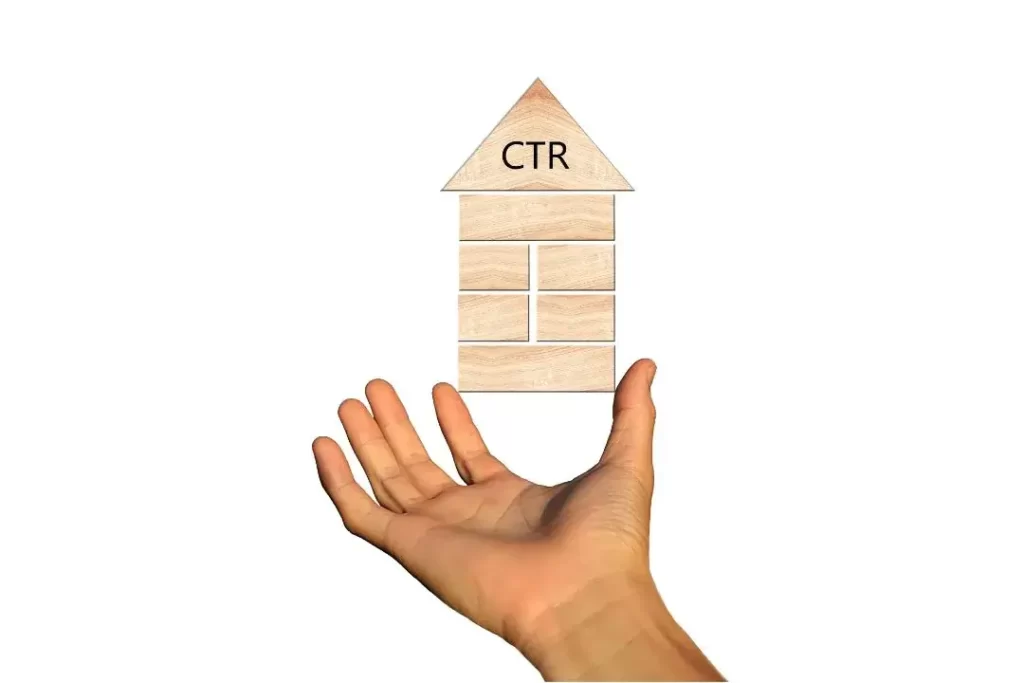
How To Increase CTR Of Websites - Dominate Your Market!
“Clicks That Captivate: Unveiling Proven Strategies to Enhance Website CTR!”
Did you know that websites with a CTR of 1% or less struggle to gain traction and witness minimal user engagement? Meanwhile, those boasting a CTR of 5% or more experience a significant surge in organic traffic, conversions, and revenue. Every website owner shares the dream of capturing the hearts and clicks of their visitors. But here’s the bitter truth: without a compelling Click-Through Rate (CTR), your website may be drowning in obscurity, lost in the sea of competitors. In this blog post, we will discuss how to increase CTR of websites through a fresh and innovative approach that will breathe new life into your digital strategy.
What is CTR (Click-Through Rate)?

CTR is defined as the ratio that shows how many people were drawn to click on your captivating content, divided by how many people saw it. The result is a percentage that reveals the potential of your website.
For Example, your website got 1,000 visits, and among those, your content earned 100 clicks. For CTR, you take the number of clicks (100) and divide it by the total visits (1,000). The result, a percentage of 10%, shows that 10% of your visitors couldn’t resist clicking.
Why is CTR Important?
Now, you must be wondering, “Why is it important?” for it binds you to your audience, reveals relevance, measures engagement, and opens the gates to growth.
- CTR highlights the resonance of your digital enchantments with your audience, forging a bond that propels your website toward greatness.
- A high CTR signifies that your website casts spells that align perfectly with your visitors’ desires.
- A low CTR, however, is a call to reassess and enhance your enchantments to better connect with your audience.
Let’s discuss some factors and how to increase the CTR of websites through some effective strategies.
Factors that Can Affect Your CTR

The CTR not only impacts your website’s visibility but also directly influences its conversion rate, revenue, and overall online presence. While many factors play a role in determining a website’s CTR, the following are some factors that affect your website’s CTR:
●Psychological Triggers
Crafting compelling headlines, evoking curiosity, and appealing to specific emotions such as joy, fear, or surprise can lead to higher CTRs, as people are naturally drawn to content that stirs their emotions.
●Interactive Content
Incorporating interactive elements like quizzes, polls, calculators, and surveys can transform passive readers into active participants. Interactive content not only enhances engagement but also leads users on a journey through your website, increasing the likelihood of further exploration and boosting CTR.
●Social Proof
People tend to follow the crowd, and showcasing social proof in the form of testimonials, reviews, and user-generated content can significantly influence CTR. By providing evidence of the value and credibility of your website, you instill confidence in users, compelling them to click through and explore more.
●Search Intent
Understanding user search intent is crucial for aligning your content with what users seek. Tailoring your website’s content to match various search intents, such as informational, navigational, or transactional, ensures that users find exactly what they are looking for, leading to higher CTR and improved user satisfaction.
●Device Type
Users interact differently with websites based on their device type – desktop, mobile, or tablet. Optimizing your website’s layout, design, and user interface for each device type ensures a seamless and engaging experience, ultimately increasing CTR across all platforms.
●Niche Relevance
Your website’s CTR is influenced by the industry or topic you cater to. Relevance is key to capturing the interest of your target audience. Ensuring that your content aligns with the interests and needs of your niche market will not only improve CTR but also build authority and credibility within your industry.
9 Effective Strategies: Discover How To Increase CTR of Website For Free

You must be scratching your head and thinking of some effective strategies for “How to increase CTR of websites.”There are a number of things you can do to increase your website’s CTR. Here are a few tips:
Strategy 1: Hook Your Readers with the Title
The title is a gateway to your content. The life of your article lies in those few words that peek from behind the curtain, beckoning readers to enter. But how do you create a title so enchanting that users simply can’t resist the urge to click? Let’s have a look at some tips:
Curiosity
Spark your content with a title that intrigues the reader’s imagination, leaving your audience yearning to read ahead. Employ intrigue, mystery, or even a touch of controversy to pique their interest. For instance, “The Astonishing Secret Behind…” or “Discover the Unbelievable Truth About…” will have them nibbling at the bait, eager to explore more.
Value
Offering value is the golden key to winning your readers’ hearts. Craft a title that clearly communicates the benefits they’ll reap from delving into your content. Address their pain points and present a solution they can’t afford to miss. “10 Life-Changing Tips to…” or “Unlock Your Potential with this Proven Strategy” assure them that they’ll gain something valuable, compelling them to click through.
Numbers
Humans find comfort in numbers and organization. Leverage this innate tendency by incorporating numbers into your titles. Lists, guides, and countdowns work wonders. “7 Surprising Facts About…” or “The Top 10 Strategies to Master…” assure them of concise, actionable insights, coaxing them to click and uncover your gems.
Strategy 2: Write Attractive Meta Descriptions
A well-written and appealing meta description can act as an enticing invitation, sparking curiosity and drawing users towards your content like moths to a flame. Here are a few tips:
Curiosity
Spark your content with a title that intrigues the reader’s imagination, leaving your audience yearning to read ahead. Employ intrigue, mystery, or even a touch of controversy to pique their interest. For instance, “The Astonishing Secret Behind…” or “Discover the Unbelievable Truth About…” will have them nibbling at the bait, eager to explore more.
Value
Offering value is the golden key to winning your readers’ hearts. Craft a title that clearly communicates the benefits they’ll reap from delving into your content. Address their pain points and present a solution they can’t afford to miss. “10 Life-Changing Tips to…” or “Unlock Your Potential with this Proven Strategy” assure them that they’ll gain something valuable, compelling them to click through.
Numbers
Humans find comfort in numbers and organization. Leverage this innate tendency by incorporating numbers into your titles. Lists, guides, and countdowns work wonders. “7 Surprising Facts About…” or “The Top 10 Strategies to Master…” assure them of concise, actionable insights, coaxing them to click and uncover your gems.
Strategy 3: Write Attractive Meta Descriptions
A well-written and appealing meta description can act as an enticing invitation, sparking curiosity and drawing users towards your content like moths to a flame. Here are a few tips:
Conciseness
Keep your meta descriptions succinct, ideally within 150-160 characters. Craft a captivating micro-story that captures the essence of your content while leaving room for curiosity to entice users to click through and explore further.
Know Your Audience
Understanding your target audience is pivotal in crafting meta-descriptions that resonate with their needs and desires. Address their pain points, use language that speaks to them directly, and offer a solution or benefit to compel them to click.
Employ Power Words
Infuse your meta descriptions with emotion-evoking language and powerful words that ignite curiosity, urgency, or excitement. Triggering emotional responses compels users to take action, increasing the likelihood of clicking through.
Utilize Keywords Wisely
Incorporate relevant keywords into your meta descriptions naturally. While optimizing for search engines is important, avoid stuffing keywords as it may sound robotic and unappealing to users. Strike a balance between SEO optimization and engaging language.
Be Specific and Unique
Avoid generic and clichéd phrases that offer little value to users. Instead, focus on highlighting the unique selling points of your content or the specific benefits users will gain by clicking through. Stand out from the crowd by being authentic and original.
Incorporate a Call-to-Action
End your meta description with a subtle call to action that encourages users to take the next step. Phrases like “Discover now,” “Learn more,” or “Unlock the secrets” instill a sense of action and engagement, motivating users to click.
Strategy 4: Use Descriptive URLs
When it comes to increasing Click-Through Rates (CTR) for your website, every detail matters. One often overlooked yet incredibly powerful strategy is the use of descriptive URLs. A descriptive URL is not just a mere string of characters; it’s a golden opportunity to engage users, pique their curiosity, and entice them to explore further. Here are a few tips:
Keep it Short and Sweet
Short and succinct URLs not only look cleaner but also enhance user experience. Long, convoluted URLs filled with unnecessary parameters or jargon can confuse users and deter them from clicking. Aim to keep your URLs concise while conveying the primary topic or purpose of the page.
Highlight Your Unique Selling Point (USP)
Your URLs are a valuable opportunity to highlight what makes your content stand out from the competition. Incorporate your Unique Selling Point directly into the URL to captivate users’ attention and create a sense of exclusivity.
Avoid Keyword Stuffing
While incorporating relevant keywords is crucial, avoid stuffing your URLs with excessive keywords. Keyword stuffing not only makes URLs look spammy but also reduces their effectiveness. Strike a balance between being descriptive and maintaining readability.
Utilize Hyphens for Clarity
When separating words in your URLs, opt for hyphens instead of underscores. Search engines and users recognize hyphens as word separators, which improves readability and ensures that your URL is easily understood.
Embrace Lowercase Letters
Consistency is key in website design, and using lowercase letters in your URLs is a best practice. It prevents potential case-sensitivity issues and keeps URLs uniform throughout your site.
Strategy 5: Implement Long-Tail Keywords
Long-tail keywords hold the key to boosting your CTR and driving targeted traffic, allowing you to attract highly relevant visitors who are more likely to engage with your content and, ultimately, click through your website. Here are some tips:
Get Descriptive and Specific
Long-tail keywords thrive on specificity. Instead of targeting broad terms like “healthy recipes,” go for more descriptive phrases like “easy gluten-free dinner recipes” or “low-carb keto breakfast ideas.” Specificity not only attracts more qualified visitors but also helps your content stand out in search engine results.
Competition
One of the most significant advantages of long-tail keywords is their lower competition compared to generic terms. With fewer websites targeting these specific phrases, you have a better chance of ranking higher in search engine results. Keep an eye on your competitors and seek opportunities where you can dominate with your long-tail keyword strategy.
Quality Content is King
Keywords alone won’t cut it; you need high-quality, valuable content to keep visitors engaged. Craft your content with the user’s Intent in mind, addressing their needs and providing actionable insights. When users find immense value in your content, they are more likely to explore further, increasing your overall CTR.
Strategy 6: Optimize for Google Rich Snippets and Featured Snippets
Google Rich Snippets add a sprinkle of visual appeal to search results by displaying additional information like star ratings, reviews, cooking time, or product prices. They give users a sneak peek into your content, making it more appealing and enticing. Here are a few tips to optimize your website with Google rich snippets and featured snippets:
Target the Right Queries
Identify the common questions and search queries relevant to your content. Create content that directly addresses these queries, keeping your focus on providing valuable and concise answers. Remember, Google loves content that meets user intent!
Snippet-Friendly Formatting
Keep your content scannable and snippet-friendly. Utilize tables, lists, and schema markup to highlight important details and data. Snippets love content that’s easy to pull and present!
Nail That Featured Snippet Spot
When targeting Featured Snippets, craft a concise summary or a quick answer at the beginning of your content. Keep it between 40 to 60 words to increase the chances of Google picking it up. And yes, try to keep it unique and not copy-pasting from elsewhere!
Answer Questions Thoroughly
When targeting Featured Snippets, go the extra mile in providing comprehensive answers. Anticipate follow-up questions users might have and address them within your content. This not only boosts your chances of being featured but also showcases your expertise.
Strategy 7: Take Up More Space with Sitelinks
Think of site links as signposts leading directly to your website’s most relevant and engaging content. By taking up more space in the SERPs with site links, you not only enhance your website’s visibility but also increase the chances of users clicking through to your site. Here are a few tips for implementing site links:
Optimize Your Website Structure
To make the most of site links, your website must have a clear and logical structure. Organize your content into relevant categories, ensuring that your website’s navigation is smooth and intuitive. Search engines are more likely to display site links for websites with a well-structured layout, as it enhances the user experience and encourages higher engagement.
Use Descriptive Anchor Text
When creating site links, ensure you use descriptive and relevant anchor text. Avoid generic phrases and, instead, use specific keywords that reflect the content of the linked pages. This not only helps search engines understand your site’s structure better but also entices users to click on the site links, knowing exactly where each link will take them.
Focus on High-Traffic Pages
Identify the pages on your website that receive the most traffic or play a pivotal role in your conversion funnel. Highlight these high-impact pages as site links to make them more prominent in the SERPs. By doing so, you guide users toward your most valuable content, increasing the likelihood of them exploring further.
Leverage Internal Linking
Internal linking is a powerful SEO strategy that can indirectly impact the display of site links. By interlinking relevant pages on your website, you signal to search engines the importance and relevance of each page. This, in turn, increases the likelihood of search engines displaying your site links.
Strategy 8: Improve your poor CTR Content
Discover the secrets of turning mediocre material into compelling click-worthy masterpieces. Here are some tips for it:
Power of Storytelling
Instead of presenting mundane facts and information, weave your content into a captivating narrative. Introduce relatable characters, intriguing conflicts, and compelling resolutions that resonate with your audience.
Interactive Elements
Break away from the monotony of plain text and integrate quizzes, polls, surveys, and calculators that encourage active participation. By involving your audience, you create a personalized and immersive experience that compels them to stay longer and explore other areas of your website.
Optimize for Keywords and Search Intent
Identify relevant keywords and phrases that align with your target audience’s search intent. Craft your content around these keywords while ensuring it remains natural and flows seamlessly. When your content fulfills the users’ search intent, they are more likely to click through, knowing they’ll find precisely what they seek.
Break Down Complex Ideas
Use clear headings, bullet points, and concise paragraphs to enhance readability. When your content is accessible and easy to understand, users are more inclined to engage and explore further.
Strategy 9: Improve your Page Loading Time
Let’s discuss the ultimate pit-stop strategy that will turn your website into a high-performance speed demon, leaving users impressed and clicking through like never before. Here are the tips:
Image Compression
Optimize your images through compression without compromising on quality. There are various tools available online to help you with this mission, ensuring your images look sharp and load swiftly, captivating your audience from the get-go.
Minimize HTTP Requests
Every element on your website, be it an image, script, or CSS file, sends an HTTP request. The more requests your website makes, the slower it loads. Eliminate any non-essential elements and combine files where possible. Less clutter means faster loading and a website that sparks joy for users.
Caching
By storing a static version of your web pages in the user’s browser, you reduce the need for repeated server requests. Embrace browser caching and witness the boost in loading time as users return to your site, already primed for action.
Server Response Time
Your website’s engine depends on the power of your hosting server. Opt for a reputable hosting provider that offers reliable and fast server response times. A high-performance hosting server is like a finely-tuned engine, propelling your website forward with lightning speed.
Content Delivery Network (CDN)
By distributing your website’s resources across multiple servers worldwide, a CDN ensures faster loading times for users, irrespective of their geographical location.
Streamline CSS and JavaScript
Messy and bloated CSS and JavaScript code can significantly slow down your website. Remove unused code, minify your CSS and JavaScript files, and adopt asynchronous loading for non-essential scripts. Your website will thank you with a turbocharged loading time. If you want to learn more about javascript click here.
Strategy 10: Localize Your Content
It’s about adapting your content to resonate with specific cultures, regions, and communities. Here are some tips:
Language that Resonates
Instead of relying solely on automated translation tools, invest in native speakers who understand the cultural nuances of your target audience. Use phrases, idioms, and expressions that locals use, and avoid slang or jargon that might not translate well.
Regional References Rock
Connect with your audience by incorporating regional references and contextually relevant examples. Mention local landmarks, events, or traditions that locals can relate to, and you’ll instantly strike a chord.
Localized SEO Matters
Optimize your website for local SEO by using location-specific keywords, meta tags, and descriptions. This will boost your website’s visibility in local searches, attracting more relevant traffic.
Stay Updated on Trends
Culture evolves, and so should your localized content. Stay in the loop with current events, trends, and pop culture references in the target region. Updating your content accordingly shows you’re present and engaged.
Conclusion
The concept of CTR determines how many people click on your site when they see it in search results. How to increase CTR of websites is no longer a mystery; it’s a journey of empowerment and enchantment that lies within your grasp. So follow the strategies stated above and increase CTR of your website.
frequently asked questions
A good organic CTR can vary by industry but generally ranges from 3% to 5%.
Organic CTR is crucial as it indicates how many users are clicking through to your site from search results, impacting your visibility and rankings.
A low CTR may result from irrelevant meta information, unappealing titles, slow loading speed, or poor mobile responsiveness.
A high CTR is generally positive, but it must align with user intent and conversion goals to truly benefit your website.
Yoast Preview allows you to optimize meta descriptions and titles, making your content more enticing and relevant to users’ searches.
Yes, tailoring content and offers to individual users’ preferences can create a sense of exclusivity and increase CTR.
Incorporating narratives in your content can captivate users’ emotions and keep them engaged, leading to higher CTR.
Ensure your website is responsive, has easy navigation, and features clear calls-to-action for a seamless mobile experience.
Yes, showcasing testimonials, reviews, and user-generated content can build trust and encourage more clicks from users.
Localized SEO Matters
Most Popular


Types Of Websites

Types of Keywords

What Is Sitemap
Social Share
Categories
Subscribe To Our Weekly Newsletter
No spam, notifications only about new products, updates.

How to Disable Comments on WordPress
An Ultimate Step-By-Step Guide: How to Disable Comments on WordPress Just In The Nick Of Time A Quick Guide – Learn how to disable comments

Types Of Websites
Dream, Create, Inspire: 15 Types Of Websites You Can Create In 2023! Stay Ahead of the Curve: Trendsetting Website Concepts for 2023! The Internet is

Types of Keywords
The Ultimate Guide to 17 Types of Keywords You Can’t Ignore “Discover, Target, Succeed: The Power of Keywords Revealed!” 3.5 billion searches are carried out

What Is Sitemap
What Is Sitemap And Why Your Website Must Have One If You Wish To Rank Top On Google “Make Your Website Get Crawled And indexed

How Google Evaluates Links for SEO
Linking the Dots: How Google Evaluates Links For SEO? “Linking Up with Google: Your Guide to Mastering SEO Through Link Evaluation” Links, sometimes known as
How to Add Facebook Pixel Code in WordPress
How to Add Facebook Pixel Code in WordPress Free! Your Ultimate Step-By-Step Guide “Transform Visitors into Valuable Insights for Ultimate Marketing Triumph” Facebook Pixel is
